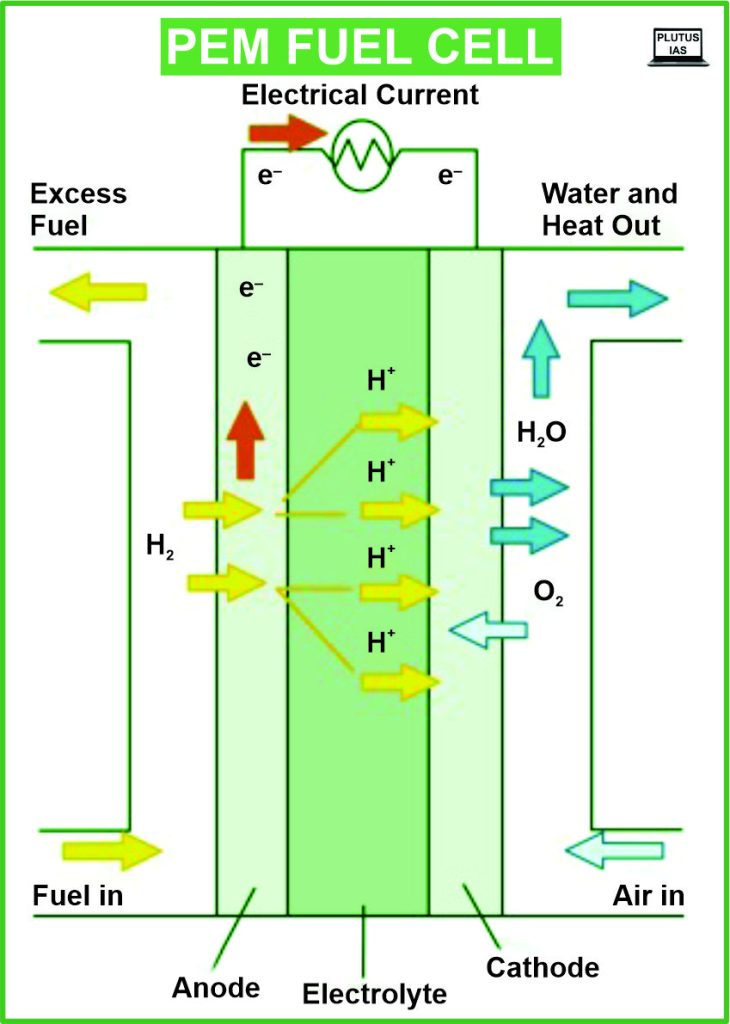12 Jan Successful testing of PEM fuel cell by ISRO
This article covers ‘Daily Current Affairs’ and the topic details of ‘successful testing of PEM fuel cell by ISRO.’’ This topic is relevant in the “Science and Technology” section of the UPSC CSE exam.
UPSC MAINS GS3 Syllabus : Indigenization of technology
Why in the News?
ISRO has achieved success in testing a 100 W class Polymer Electrolyte Membrane Fuel Cell (PEMFC)-based Power System aboard the orbiting vehicle POEM3. POEM3, which was launched onboard PSLV-C58.
About PEMFC Test
- Its goal is to evaluate Polymer Electrolyte Membrane Fuel cell operation in space and collect data that will help in the layout of systems for upcoming missions.
- It is an electric generator that operates on electrochemical principles, similar to those used in batteries, rather than the combustion reactions used in traditional generators.
- ISRO tested a PEMFC of 100 watts that transforms both oxygen and hydrogen into energy, water, and heat. This method has various advantages over typical space power sources, which includes: (a) PEMFCs convert gasoline directly into energy, resulting in much higher efficiency than batteries.
(b) PEMFCs emit just water as a byproduct, avoiding the need for sophisticated waste management systems.
(c) The PEMFC water can be utilised for onboard consumption or electrolysis to generate extra oxygen.These characteristics make them excellent choices for space travel by human missions when electric power, water, and heat are required because a single system may handle numerous mission needs. - Fuel Cells have enormous societal potential for application as well –
(a) They are regarded as the best choice for replacing engines in various vehicles and powering backup power systems today.
(b) It can provide the same range and fuel recharge time as a traditional engine, providing it an unambiguous benefit over batteries, and is projected to promote emission-free transportation.
Applications for future missions
- Fuel cells are ideal for manned space missions because they provide critical power, water, and heat from just one device.
- PEMFCs are perfect for running the envisioned Indian space station due to their great efficiency and water production capabilities.
- PEMFCs have the potential to provide a dependable and sustainable source of power for long-duration journeys to deep space destinations like Mars.
- Fuel cells have comparable performance and refuelling time to conventional engines and are intended to provide emission-free transportation.
About POEM (PSLV Orbital Experimental Module) initiative
- Energy generation, telemetry, telecommand stabilisation, orbital station holding, and orbital manoeuvring are all supported by ISRO’s POEM platform, which has standard interfaces and packaging.
- This enables space agencies and private enterprises to create, test, and evaluate experimental orbital payloads.
- ISRO’s PSLV rocket is a four-stage rocket in its conventional configuration.
(a) The first three spent stages re-enter the water, while the fourth goes up in space as debris after sending satellites into orbit.
(b) The POEM programme, on the other hand, uses the wasted final stage as a “stabilised platform to conduct experiments.”
What is a Fuel Cell?
- A fuel cell is a type of an electrochemical device that directly transforms the chemical energy of a fuel (such as hydrogen) and an oxidant (such as oxygen) into electricity.
- Unlike batteries, which store chemical energy before converting it to electrical energy, fuel cells produce electricity continuously for as long as they are supplied with fuel and an oxidant.

How Fuel Cell works or its operation
- At the anode, hydrogen molecules (H2) are divided into protons (H+) and electrons (e-). Only protons can travel through the PEM to the cathode.
- Electrons pass through an external circuit to the cathode, creating an electric current.
- At the cathode, oxygen molecules (O2) from the air interact with protons and electrons to generate water (H2O).
- Heat is produced during the reaction, and this heat can be exploited to heat certain applications.
Some important types of fuel cell –
- Polymer Electrolyte Membrane Fuel Cells: These fuel cells are perfect for portable applications since they incorporate a thin but solid polymer membrane as the electrolyte.
- SOFCs (Solid Oxide Fuel Cells): SOFCs have a ceramic electrolyte which can withstand high temperatures. They are more expensive and sophisticated than PEMFCs, but they are more efficient.
- Alkaline Fuel Cells (AFCs): AFCs use a potassium hydroxide (KOH) liquid electrolyte. They tend to be less efficient in comparison to PEMFCs and SOFCs, but they are more affordable and more tolerant of fuel impurities.
Download plutus ias current affairs eng med 12th Jan 2024
Prelims practice question
Q1) What environmental benefit is associated with PEM Fuel Cells?
A) Increased air pollution
B) Reduced greenhouse gas emissions
C) Depletion of ozone layer
D) Soil contamination
Answer: B
Q2) What is the byproduct of the electrochemical reaction in a PEM Fuel Cell?
A) Water
B) Carbon dioxide
C) Nitrogen
D) Oxygen
Answer: A
Mains practice question
Q1) How can PEMFCs contribute to addressing energy storage challenges in renewable energy systems?
Q2) What are the key advantages of Polymer Electrolyte Membrane Fuel Cells over other types of fuel cells?
I am a content developer and have done my Post Graduation in Political Science. I have given 2 UPSC mains, 1 IB ACIO interview and have cleared UGC NET JRF too.



No Comments